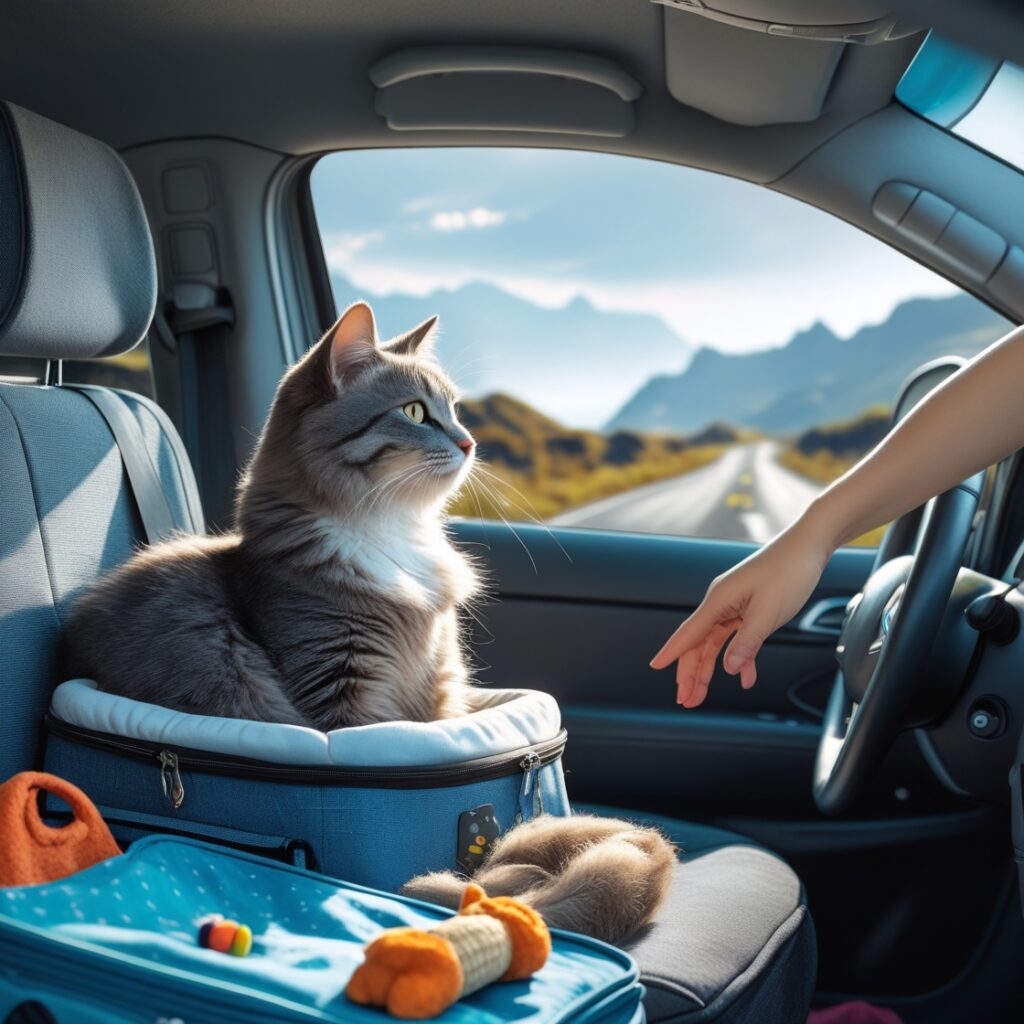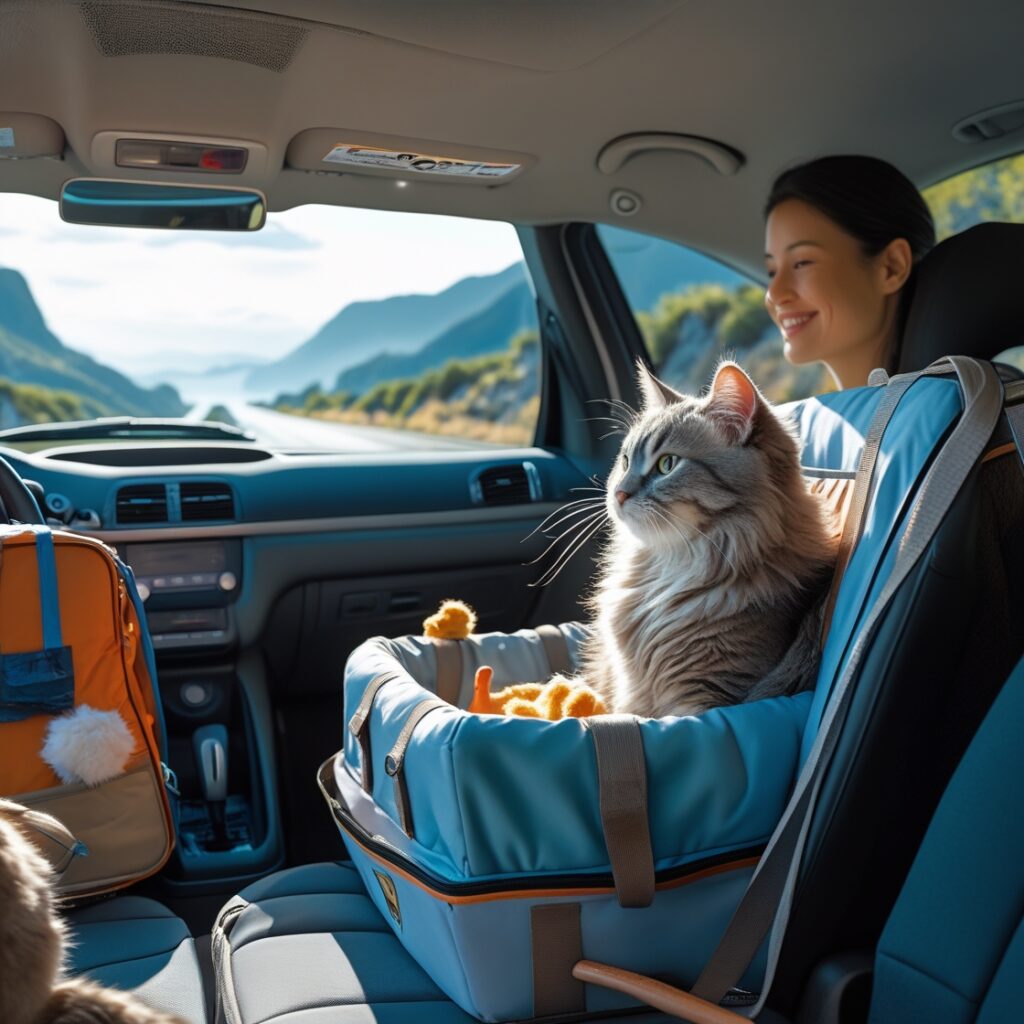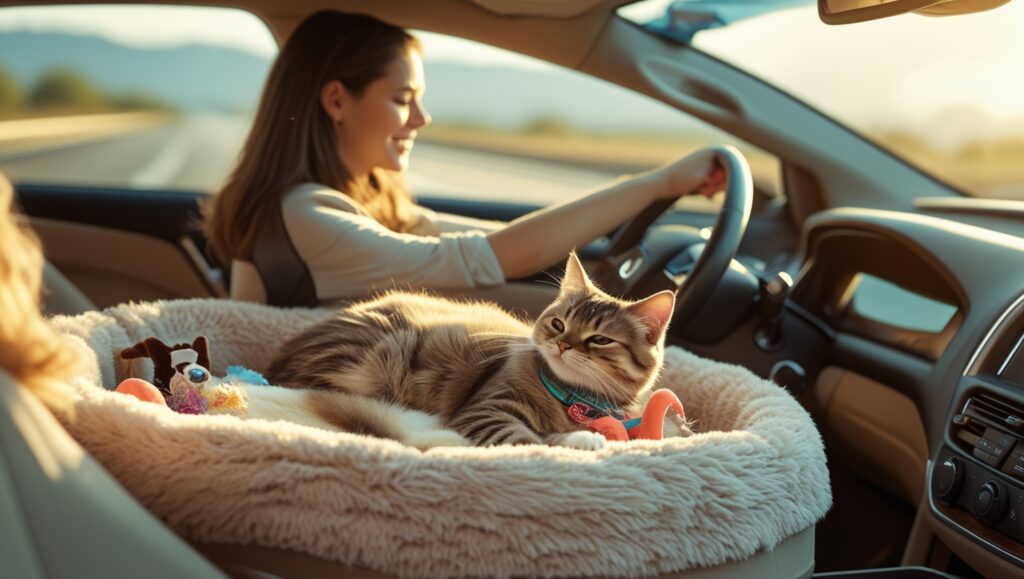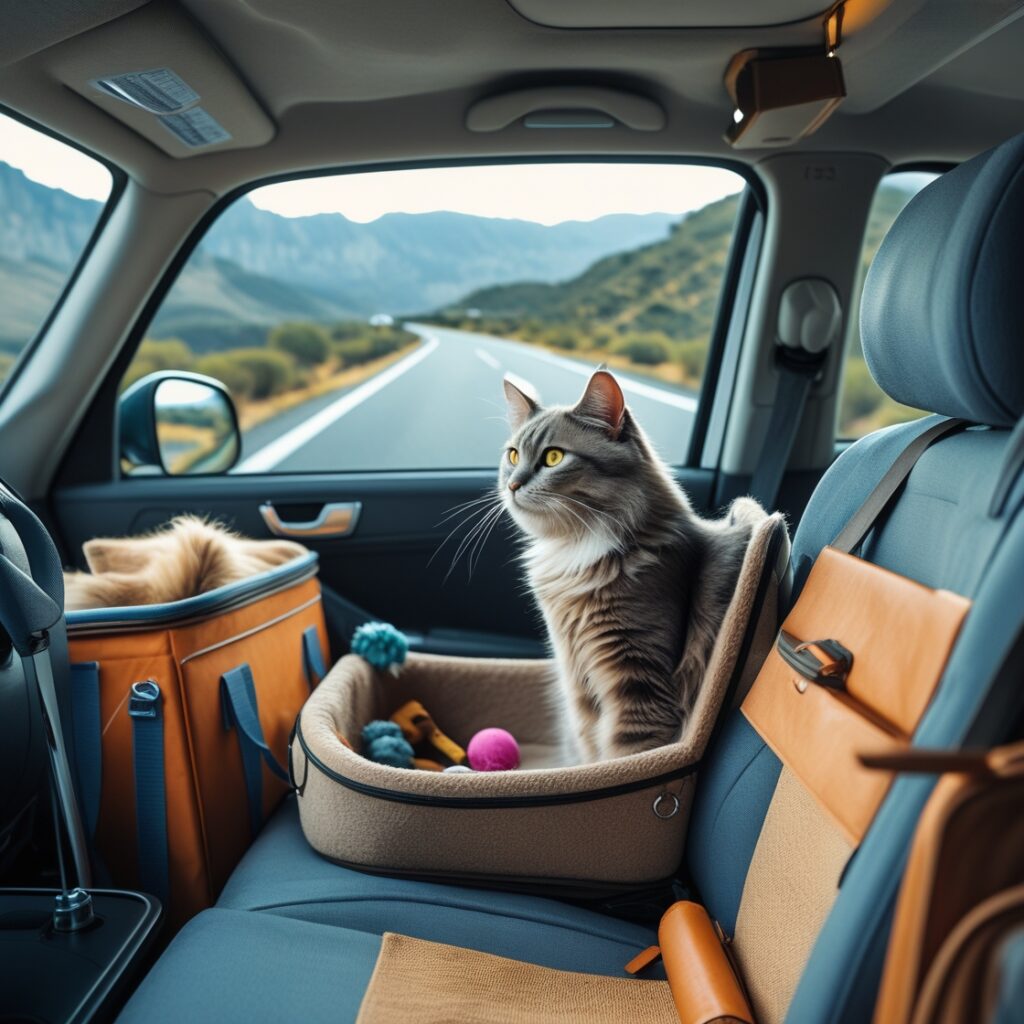How to Travel with a Cat in a Car Long Distance USA
Traveling long distances with a cat in a car can be challenging, but with proper preparation, it can be a smooth and stress-free experience for both you and your feline companion. Whether you’re relocating or taking a road trip, ensuring your cat’s comfort, safety, and well-being is essential.
Outline of the Article:
1. Introduction
- Why traveling with a cat requires special preparation
- The importance of keeping your cat comfortable and safe
2. Preparing Your Cat for Long-Distance Travel
- Getting your cat used to the carrier
- Short practice trips to reduce anxiety
- Scheduling a vet visit before the trip
3. Choosing the Right Carrier for Your Cat
- Hard vs. soft carriers: Which is best?
- Ensuring proper ventilation and security
- Adding comfort with bedding and familiar scents
4. Packing Essentials for Your Cat
- Food, water, and treats
- Litter box solutions for road trips
- Cat-friendly travel accessories
5. Creating a Safe and Comfortable Car Environment
- Where to place the carrier in the car
- Maintaining a comfortable temperature
- Reducing noise and distractions
6. Managing Your Cat’s Anxiety During the Trip
- Calming techniques and pheromone sprays
- Using covers to minimize stress
- Playing soothing music for relaxation
7. Feeding and Hydration During the Journey
- How often to feed your cat on the road
- Keeping your cat hydrated
- Preventing motion sickness
8. Handling Rest Stops and Breaks
- How often to stop for breaks
- Letting your cat stretch safely
- Keeping your cat secure while outside the car
9. Dealing with Motion Sickness and Other Health Concerns
- Signs of car sickness in cats
- Medications and natural remedies
- When to contact a vet during the trip
- How to Travel with a Cat in a Car Long Distance USA
10. Overnight Stays and Pet-Friendly Hotels
- Choosing cat-friendly accommodations
- Setting up a temporary safe space
- Keeping your cat comfortable in a new environment
11. Traveling Across State Lines: Legal and Safety Considerations
- Required paperwork for interstate travel
- State-specific pet travel regulations
- Microchipping and ID tags for safety
12. What to Do If Your Cat Escapes or Gets Lost
- Steps to take immediately
- Using GPS trackers for extra security
- How to prevent escape situations
13. Entertaining Your Cat During the Trip
- Toys and activities to keep them engaged
- Interactive play inside the car
- Preventing boredom-related anxiety
14. Arriving at Your Destination
- Helping your cat adjust to the new environment
- Setting up a comfortable resting space
- Gradually introducing them to their new home
15. Final Tips for a Stress-Free Trip
- Recap of key takeaways
- Encouragement for first-time travelers
- Common mistakes to avoid

How to Travel with a Cat in a Car Long Distance USA
1. Introduction
Taking your cat on a long car trip across the U.S. is not as simple as putting them in the car and hitting the road. Unlike dogs, most cats are not natural travelers. They are territorial animals that feel safest in familiar environments. When placed in a moving vehicle, they can experience stress, anxiety, and motion sickness.
To ensure a smooth journey, proper planning and preparation are key. From choosing the right carrier to managing their anxiety, every aspect of the trip should be tailored to your cat’s needs. This guide will help you understand how to travel long distances with a cat in a car while ensuring their safety and comfort.How to Travel with a Cat in a Car Long Distance USA
2. Preparing Your Cat for Long-Distance Travel
Before embarking on a long journey, preparing your cat for the trip is essential. Here’s how you can do it:
Get Your Cat Used to the Carrier
Most cats associate a carrier with vet visits, which can make them anxious. To create a positive association:
- Leave the carrier open at home for a few weeks before the trip.
- Place treats, toys, or bedding inside to make it a cozy spot.
- Let your cat explore it voluntarily without forcing them inside.
Take Short Practice Trips
If your cat has never traveled in a car, take them on short practice drives. This helps them get used to the motion and sounds of a moving vehicle. Start with 5-10 minute trips and gradually increase the duration.
Schedule a Vet Visit
A health check-up before the trip ensures that your cat is fit for travel. Ask your vet about:
- Motion sickness medication if needed
- Sedation options for highly anxious cats
- Vaccination and health certificates required for crossing state lines
3. Choosing the Right Carrier for Your Cat
The right carrier can make a huge difference in your cat’s comfort during a long journey.
Hard vs. Soft Carriers
- Hard carriers offer more protection and are easier to clean.
- Soft carriers are lightweight and more comfortable but may lack durability.
Size and Ventilation
- The carrier should be spacious enough for your cat to stand, turn around, and lie down comfortably.
- Proper ventilation is crucial to ensure fresh air circulation.
Adding Comfort
- Line the carrier with a soft blanket or your cat’s favorite bedding.
- Place a piece of your clothing inside to provide a familiar scent.
4. Packing Essentials for Your Cat
Being well-prepared with the right supplies can prevent last-minute stress.
Food, Water, and Treats
- Bring enough of your cat’s regular food to last the trip.
- Pack collapsible water and food bowls.
- Use bottled or familiar water to avoid stomach issues.
Litter Box Solutions
- Portable litter boxes are ideal for travel.
- Use disposable litter trays or a small storage container with cat litter.
- Place puppy pads in the carrier for accidents.
Other Essentials
- A leash and harness for secure bathroom breaks
- Favorite toys to keep your cat engaged
- Waste bags for easy clean-up
- How to Travel with a Cat in a Car Long Distance USA
5. Creating a Safe and Comfortable Car Environment

Where you place your cat’s carrier in the car and how you manage the environment can affect their stress levels.
Best Placement for the Carrier
- Secure the carrier on the floor behind the front seat to prevent it from moving.
- Avoid placing it in the front seat due to airbags.
Maintaining a Comfortable Temperature
- Keep the car’s temperature moderate, avoiding direct heat or cold drafts.
- Use sunshades on windows if traveling in hot weather.
Minimizing Stress Factors
- Avoid loud music or sudden noises.
- Speak to your cat in a calming voice during the trip.
- Consider covering part of the carrier with a breathable cloth to create a cozy den-like space.How to Travel with a Cat in a Car Long Distance USA
6. Managing Your Cat’s Anxiety During the Trip
Cats are sensitive to changes in their environment, and a long car ride can be overwhelming. Reducing their anxiety is crucial to making the journey smooth for both of you.
Calming Techniques and Pheromone Sprays
- Use feline pheromone sprays (such as Feliway) inside the carrier to create a sense of familiarity and calmness.
- Try calming supplements or natural remedies like catnip or valerian root, but consult your vet first.
- Speak softly to reassure your cat and avoid sudden loud noises.
Using Covers to Minimize Stress
- Covering the carrier with a light blanket or towel can reduce visual stimuli and create a den-like feeling, making your cat feel safer.
- Ensure the cover allows proper air circulation and doesn’t overheat your cat.
Playing Soothing Music for Relaxation
- Gentle classical music or special “cat calming” playlists can help reduce stress.
- Avoid loud or abrupt sounds, and keep the volume low.
7. Feeding and Hydration During the Journey
Proper nutrition and hydration are critical during long trips, but they require a different approach than at home.
How to Travel with a Cat in a Car Long Distance USA
How Often to Feed Your Cat
- If your trip is less than 6 hours, you can wait until you arrive before feeding your cat.
- For longer trips, offer small amounts of food every 6-8 hours to avoid motion sickness.
- Avoid feeding a big meal right before departure to prevent nausea.
Keeping Your Cat Hydrated
- Offer fresh water every 2-3 hours, using a spill-proof bowl or a pet travel bottle.
- Some cats prefer drinking from a syringe or a small spoon rather than a bowl.
Preventing Motion Sickness
- Signs of motion sickness include drooling, whining, and vomiting.
- Keeping the car cool and well-ventilated can help reduce nausea.
- Ask your vet about anti-nausea medications if needed.
8. Handling Rest Stops and Breaks
Taking breaks is necessary for long drives, but letting your cat out requires special precautions.
How Often to Stop for Breaks
- Plan a stop every 3-4 hours to check on your cat and offer water.
- Avoid frequent stops if your cat is calm and comfortable in their carrier.
Letting Your Cat Stretch Safely
- Never let your cat roam freely in the car or outside at rest stops.
- Use a secure harness and leash if you plan to take them out for a quick stretch.
- How to Travel with a Cat in a Car Long Distance USA
Keeping Your Cat Secure While Outside the Car
- Always ensure all doors and windows are closed before opening the carrier.
- If your cat seems stressed, it’s best to keep them inside the carrier rather than forcing them out.
9. Dealing with Motion Sickness and Other Health Concerns

Signs of Motion Sickness in Cats
- Excessive drooling
- Vomiting
- Whining or meowing
- Lethargy or discomfort
Medications and Natural Remedies
- Over-the-counter remedies like Dramamine or Cerenia (ask your vet for dosage).
- Natural solutions include ginger-infused treats or pheromone sprays.
When to Contact a Vet During the Trip
- If your cat refuses to eat or drink for more than 12 hours.
- If they experience severe vomiting or diarrhea.
- If they show signs of distress that don’t improve with calming techniques.
10. Overnight Stays and Pet-Friendly Hotels
If your trip requires an overnight stay, choosing a cat-friendly hotel is essential.
Choosing Cat-Friendly Accommodations
- Use pet-friendly hotel directories like BringFido or PetsWelcome.
- Call ahead to confirm pet policies and any additional fees.
Setting Up a Temporary Safe Space
- Place the carrier in a quiet corner of the hotel room.
- Let your cat explore at their own pace but keep the door closed at all times.
- Set up food, water, and a travel litter box in a familiar way.
Keeping Your Cat Comfortable in a New Environment
- Use their favorite blanket or toy for familiarity.
- Keep their routine as normal as possible.
- Avoid leaving them alone in an unfamiliar place.
- How to Travel with a Cat in a Car Long Distance USA
11. Traveling Across State Lines: Legal and Safety Considerations
Required Paperwork for Interstate Travel
- Some states require a health certificate from a vet for pet travel.
- Carry your cat’s vaccination records in case they are needed.
State-Specific Pet Travel Regulations
- Some states have strict pet importation laws (e.g., Hawaii).
- Research travel laws using the USDA pet travel website.
Microchipping and ID Tags for Safety
- Ensure your cat’s microchip is up-to-date before traveling.
- Attach an ID tag with your contact info to their harness.
12. What to Do If Your Cat Escapes or Gets Lost
Even with precautions, accidents can happen. Here’s what to do if your cat gets lost.
Steps to Take Immediately
- Stay calm and search the immediate area.
- Call your cat’s name softly and offer food or treats.
- Use a familiar scent, like their blanket, to attract them.
Using GPS Trackers for Extra Security
- Consider using a GPS pet tracker on their collar for real-time location tracking.
- Popular options include Whistle, Tractive, or AirTag.
How to Prevent Escape Situations
- Always double-check carriers before opening them.
- Secure car doors and windows at all times.
- Keep them on a leash and harness during breaks.
- How to Travel with a Cat in a Car Long Distance USA
13. Entertaining Your Cat During the Trip
Toys and Activities to Keep Them Engaged
- Pack favorite toys like softballs, catnip mice, or chewable treats.
- Use interactive toys to keep them entertained.
Interactive Play Inside the Car
- Wiggle a feather wand through the carrier bars.
- Offer small treat-dispensing puzzles for mental stimulation.
Preventing Boredom-Related Anxiety
- Rotate toys every few hours to keep them engaged.
- Provide a window view if it calms your cat.
14. Arriving at Your Destination

Helping Your Cat Adjust to the New Environment
- Start by confining them to one room before giving them full access.
- Allow them to explore at their own pace.
Setting Up a Comfortable Resting Space
- Place their favorite blanket, food, and litter box in a quiet area.
- Keep noise levels low until they settle in.
Gradually Introducing Them to Their New Home
- Let them explore one area at a time.
- Stick to a routine to help them adjust.
15. Final Tips for a Stress-Free Trip
Key Takeaways
- Plan ahead to ensure a smooth trip.
- Keep your cat secure and comfortable in a proper carrier.
- Monitor their stress levels and use calming techniques.
- Pack all essential supplies to avoid last-minute stress.
Common Mistakes to Avoid
- Letting your cat roam freely in the car.
- Skipping practice trips before a long journey.
- Ignoring signs of stress or motion sickness.
- How to Travel with a Cat in a Car Long Distance USA
By following these steps, you can ensure a safe and stress-free trip for both you and your feline friend. Happy travels!

FAQs
1. Can I let my cat roam freely in the car?
No, it’s unsafe. Always keep your cat secured in a well-ventilated carrier.
2. What if my cat refuses to eat or drink?
Offer small amounts frequently. Try using a syringe for water if necessary.
3. Should I sedate my cat for travel?
Only under veterinary supervision. Sedation can have side effects.
4. How do I stop my cat from crying in the car?
Use pheromone sprays, and soothing music, and cover the carrier partially.
5. Can I take my cat on a long road trip without a litter box?
No, always bring a travel-friendly litter box for their comfort. How to Travel with a Cat in a Car Long Distance USA